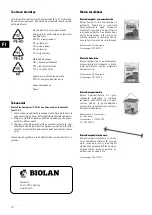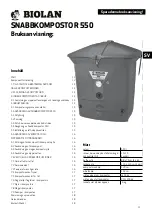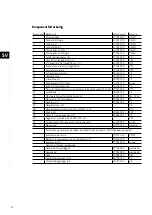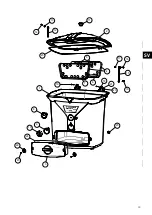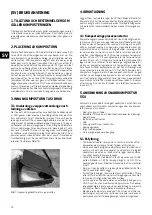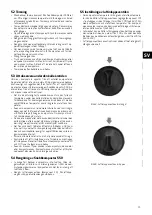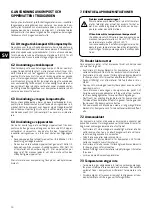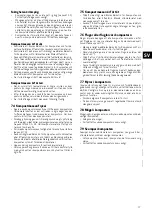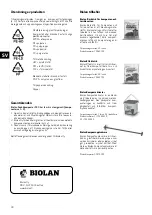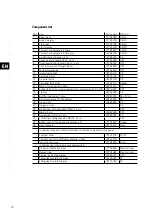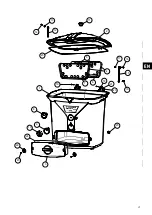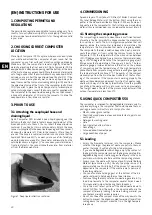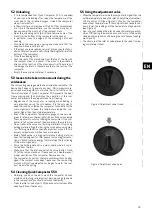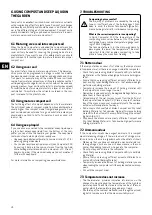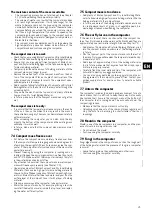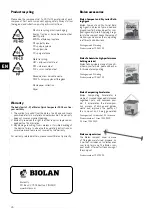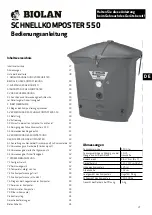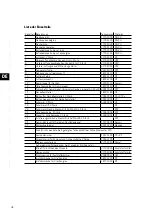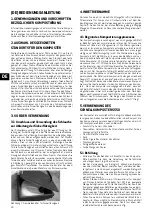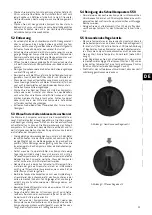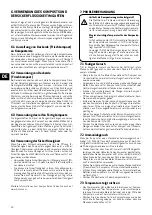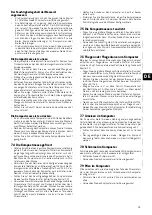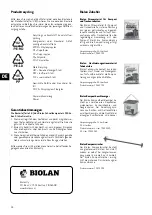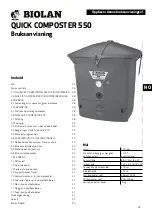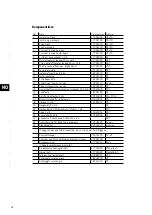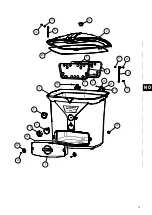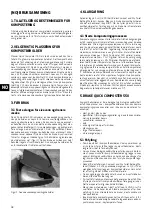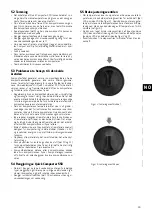
24
FI
SV
EN
DE
NO
ET
LV
LT
RU
FR
PL
CS
6. USING COMPOST AND SEEP LIQUID IN
THE GARDEN
Compost is an excellent soil conditioner and contains nutrients
with a long-lasting effect for plants to use. Compost soil changes
and develops constantly and should be used in a different man-
ner in the different stages of its development. Compost soil is
usually divided into two groups based on how mature it is: semi-
mature cover soil and mature compost soil.
6.1 Maturing cover soil into compost soil
When the Quick Composter is unloaded, the compost mass has
usually matured to the cover soil phase. It is recommended that
cover soil only be used for covering the growing beds of orna-
mental plants. If you want to use it for edible plants, you should
post-compost it for another year to mature the mass into proper
compost soil.
6.2 Using cover soil
Cover soil refers to semi-mature compost mass. The decompo-
sition process has progressed to a stage in which food waste
has decomposed. Harder wood matter and eggshells and citrus
fruit peels, for example, may still be visible, so cover soil looks
coarse. Semi-mature compost may still contain substances that
will impede growth and germination, so it should not be used as a
growing medium. Cover soil is not harmful to plants when spread
to cover the beds of ornamental plants in a layer of a couple of
centimetres. This will allow the nutrients contained in the com-
post to release for the plants to use.
6.3 Using mature compost soil
The fertilizing effect of compost depends on its raw materials.
The nutritional value of compost made from household waste is
usually higher than compost made from gardening waste. Com-
post soil alone does not make for a good substrate; instead, you
should add one-third to half of mineral soil, such as sand, silt,
loam or clay.
6.4 Using seep liquid
If you use a hose connected to the composter’s seep liquid open-
ing to collect excess seep liquid from the bottom of the com-
poster, you can utilise the liquid in your garden. The seep liquid
contains nutrients which plants can readily use.
• Use seep liquid diluted with water (a minimum ratio of 1:2) for
watering your garden plants.
• You can also recycle seep liquid in your Quick Composter 550
by pouring it back into the compost mass from the top. Add
some bulking material and absorb a maximum of 5 litres of
liquid in it per day. If the mass is already wet, do not moisten it
further with seep liquid.
For more information on composting, see www.biolan.com
7. TROUBLESHOOTING
Composting not successful?
The majority of problems are caused by the wrong
type or insufficient use of the bulking agent. Also
keep in mind the Biolan Tehokuivike high-perfor-
mance bulking material for cold-season composting.
What is the correct temperature in composting?
In Quick Composter 550, the temperature of the
composting mass varies b10–70 degrees
centigrade. A very common temperature gauge read-
ing is +30–40 degrees.
The less waste there is for the micro-organisms to
decompose, the lower the temperature. The most
important factor that enables composting to take
place is to keep the mass from freezing.
7.1 Rotten odour
If the composter has an odour of rot or decay, the compost mass
is too dense or wet, or there is no oxygen inside the composter.
• Check that you are using Biolan Compost and Dry toilet Bulk-
ing Material or the Tehokuivike high-performance bulking ma-
terial.
• Ensure that you are using sufficient amounts of Biolan Com-
post and Dry toilet Bulking Material or the Tehokuivike high-
performance bulking material.
• Temporarily increase the amount of bulking material until
the compost mass is no longer too wet.
• Remember to open and empty biodegradable bags before you
place them in the composter.
• Unload some of the wet compost mass from the bottom of
the composter (see Chapter 5.2). Place a couple of centime-
tres of the mass around your ornamental plants. The unpleas-
ant odour will dissipate in a few days.
• Add a couple of shovelfuls of Biolan Compost and Dry toilet
Bulking Material or Tehokuivike high-performance bulking
material to the bottom of the composter through the unload-
ing hatch (part 3).
• Drop down the mass and mix plenty of Biolan Compost and
Dry toilet Bulking Material or Tehokuivike high-performance
bulking material in it.
7.2 Ammonia odour
If the composter smells like pungent ammonia, the compost
mass is releasing nitrogen. If there is too much of nitrogen in re-
lation to carbon, the micro-organisms will not be able to utilise it.
• Make sure that you have not added too much materials con-
taining nitrogen, such as urine or chicken manure, in the com-
poster. Stop adding too much nitrogen into the composter.
• Do not put any ash or lime in the composter.
• Check that you are using Biolan Compost and Dry toilet Bulk-
ing Material.
• Ensure that you are using sufficient amounts of Biolan Com-
post and Dry toilet Bulking Material.
• Temporarily increase the amount of bulking material you use
when loading the composter until the unpleasant odour disap-
pears.
• Stir with the compost mixer.
7.3 Temperature does not increase
• The thermometer provides indicative information on the
phases of composting and the temperatures of the high-tem-
perature phase. The hottest area is in the centre of the com-
poster, which the temperature gauge does not reach.
• Mix the top of the compost mass and look through the unload-
ing hatch to make sure that the mass is suitably moist.

